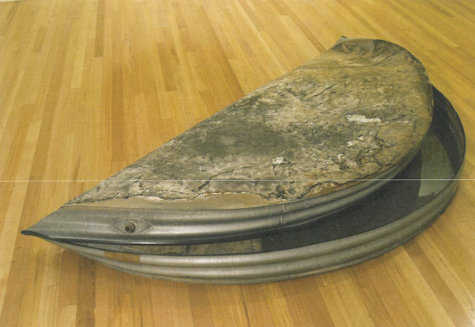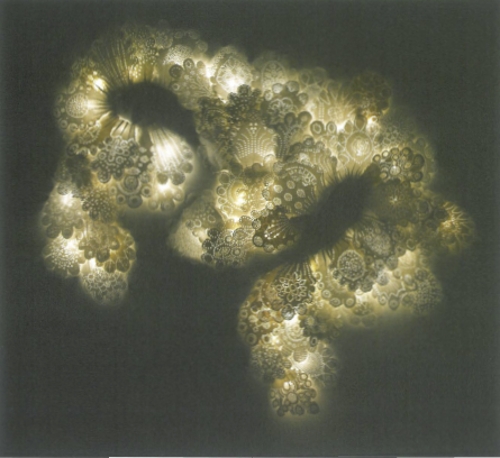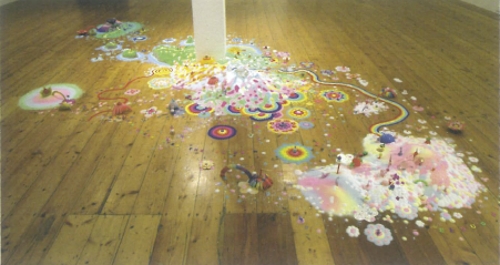
Confluence presents five artists' thoughtful responses to the strong presence of the Murray, the abundance of the wildlife it supports, and the impact of its use for agricultural purposes. As part of the Murray/Darling Palimpsest 6 project, Confluence is one of a number of exhibitions in regional Australia working on similar themes.
Malthoid has been used by Pamela Kouwenhoven as a metaphor for a parched landscape for some time now. This material is used to seal the bottom of water tanks, essential if the precious substance is not to be lost. Previously Kouwenhoven has used fragments of the material, but in Confluence she has not only included the malthoid in its entirety but the base of the tank to which it was attached. This base is folded in half, exposing the surface that lay closest to the earth. The malthoid is etched with the markings of landscape; you can see roads, rivers, salt lakes even.
Sentinel, Jan Clifford's haunting grove of drowned trees, provides a backdrop to Kouwenhoven's work, hinting at the stark contrasts inherent in the Murray system. Woven using natural fibres and a random weave technique Sentinel refers to trees killed by high water levels. River Red Gums tolerate occasional flooding, but the manipulation of the river's levels to allow for irrigation and navigation has drowned many trees, and the dead white trunk of a magnificent tree reaching out of a swollen river is not an uncommon sight. Clifford's use of the parasitic vine Cassytha pubescens, known locally as Snotty Gobble, gives an indication of the nature of our relationship to the river. She uses the same weaving material and technique to construct a canoe, Inscape, a quiet nod to the recreational use of the river, now the domain of the ubiquitous speed boat and jet ski.
John Hayward's thought-provoking series of small fibreglass canoes are cast from the bark of the Red Gum. The Memory Vessels series provides a memorial to the trees' lives – the blackened surface after a bush fire, the scribbly path of a moth larva eating its way to freedom and the graffiti of text carved harshly into the bark. Desert Harvest carries a carefully placed load of rice, drawing attention to the irony of growing a thirsty crop in a dry land.
The works of Ken Orchard and Stephanie Radok make a gentle comment about the landscape of the Murray. Radok draws attention to the diversity of bird life along the river by covering two walls with twenty-eight separate portraits of birds. The Egyptian Birds series of watercolours on paper link with the subtly layered mural-like Wallworks painted on unstretched canvas to create a visual connection to the fertile river region of the Nile, another place of abundance threading through an arid landscape.
A pilgrimage of sorts was undertaken by Ken Orchard that saw him tracing the journey of colonial artist Eugene von Guérard to Blanchetown. Making the trip at the same age as von Guérard and visiting the same locations on the same dates gives his work a sense of echo and homage. Orchard constructs his sensitive landscapes from composite images, worked onto the surface of the pages of an old Government Gazette thus creating a sense of depth and history.
The range of works in Confluence bring together some of the main issues related to the Murray without preaching or resorting to clichés. It can be experienced as a diverse yet contemplative exhibition of themes relating to the Murray or taken further and used as a catalyst for discussion and debate. One of the key philosophies of the Palimpsest 6 project, coordinated by Ian Hamilton, is the capacity of art to change attitudes. Like the river itself, Palimpsest is not a single event, but a continual flow of events through regional areas of the Murray Darling Basin, continually bringing us back to the issues of sustainability affecting the Murray.












